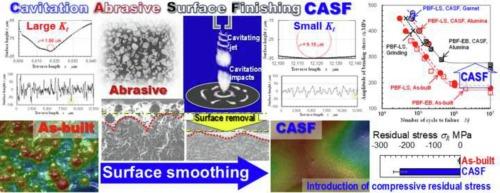Effects of the stress concentration factor and residual stress on the improvement in the fatigue properties of powder-bed-fused Ti6Al4V via cavitation abrasive surface finishing
IF 6.8
2区 材料科学
Q1 ENGINEERING, MECHANICAL
引用次数: 0
Abstract
Additively manufactured metals, such as powder-bed-fused titanium alloy (PBF/Ti6Al4V), are promising materials; however, their fatigue strength is only half that of wrought metals, which limits their practical applications. In the as-built condition, their low fatigue strength is caused by the high surface roughness due to the partially melted particles remaining on the material surface after PBF, surface defects and internal or near-surface defects. In this study, PBF/Ti6Al4V was treated by cavitation abrasive surface finishing (CASF) post-processing to improve the fatigue strength. Results were compared with those of grinding. During CASF, abrasive impacts removed the surface defects and promoted smoothing, and cavitation impacts introduced compressive residual stress. The fatigue properties were evaluated using a plane bending fatigue test. The fatigue strength of the as-built PBF/Ti6Al4V at 107 cycles was improved via CASF by up to 65 %. To quantitatively determine the effects of surface smoothing on the improvement in the fatigue properties via post-processing, the effective stress concentration factor was estimated using the surface roughness and profile valley radii. Additionally, the residual stress was determined using X-ray diffraction. The results revealed that the stress concentration factor and compressive residual stress are the key parameters to improve the fatigue strength of as-built PBF/Ti6Al4V.

应力集中系数和残余应力对空化磨料表面处理改善粉末熔敷Ti6Al4V疲劳性能的影响
增材制造的金属,如粉末床熔融钛合金(PBF/Ti6Al4V),是有前途的材料;然而,它们的疲劳强度只有锻造金属的一半,这限制了它们的实际应用。在建成状态下,由于PBF后材料表面残留部分熔化的颗粒、表面缺陷和内部或近表面缺陷导致表面粗糙度高,导致其疲劳强度低。本研究对PBF/Ti6Al4V进行了空化磨料表面处理(CASF)后处理,以提高其疲劳强度。结果与研磨法进行了比较。在CASF过程中,磨料冲击消除了表面缺陷,促进了表面光滑,空化冲击引入了压缩残余应力。采用平面弯曲疲劳试验对其疲劳性能进行了评价。经CASF处理,PBF/Ti6Al4V在107次循环下的疲劳强度提高了65%。为了定量确定表面平滑对后处理后疲劳性能改善的影响,利用表面粗糙度和轮廓谷半径估算了有效应力集中系数。此外,利用x射线衍射测定了残余应力。结果表明,应力集中系数和残余压应力是提高原位PBF/Ti6Al4V疲劳强度的关键参数。
本文章由计算机程序翻译,如有差异,请以英文原文为准。
求助全文
约1分钟内获得全文
求助全文
来源期刊

International Journal of Fatigue
工程技术-材料科学:综合
CiteScore
10.70
自引率
21.70%
发文量
619
审稿时长
58 days
期刊介绍:
Typical subjects discussed in International Journal of Fatigue address:
Novel fatigue testing and characterization methods (new kinds of fatigue tests, critical evaluation of existing methods, in situ measurement of fatigue degradation, non-contact field measurements)
Multiaxial fatigue and complex loading effects of materials and structures, exploring state-of-the-art concepts in degradation under cyclic loading
Fatigue in the very high cycle regime, including failure mode transitions from surface to subsurface, effects of surface treatment, processing, and loading conditions
Modeling (including degradation processes and related driving forces, multiscale/multi-resolution methods, computational hierarchical and concurrent methods for coupled component and material responses, novel methods for notch root analysis, fracture mechanics, damage mechanics, crack growth kinetics, life prediction and durability, and prediction of stochastic fatigue behavior reflecting microstructure and service conditions)
Models for early stages of fatigue crack formation and growth that explicitly consider microstructure and relevant materials science aspects
Understanding the influence or manufacturing and processing route on fatigue degradation, and embedding this understanding in more predictive schemes for mitigation and design against fatigue
Prognosis and damage state awareness (including sensors, monitoring, methodology, interactive control, accelerated methods, data interpretation)
Applications of technologies associated with fatigue and their implications for structural integrity and reliability. This includes issues related to design, operation and maintenance, i.e., life cycle engineering
Smart materials and structures that can sense and mitigate fatigue degradation
Fatigue of devices and structures at small scales, including effects of process route and surfaces/interfaces.
 求助内容:
求助内容: 应助结果提醒方式:
应助结果提醒方式:


